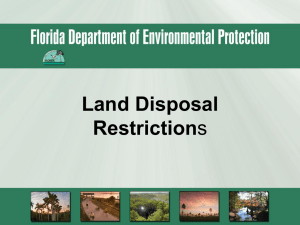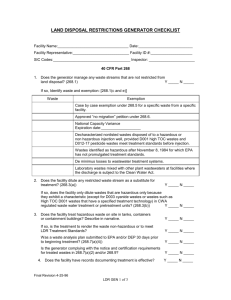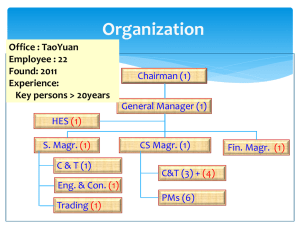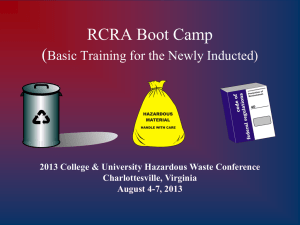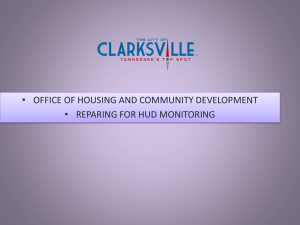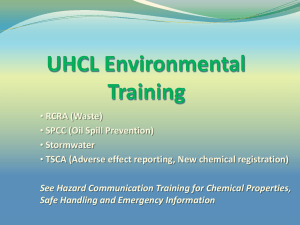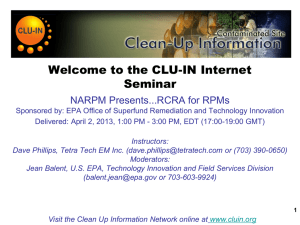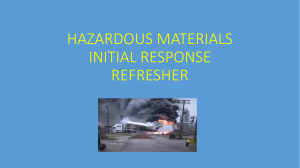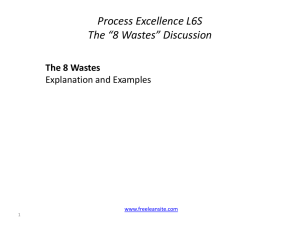Land Ban
advertisement
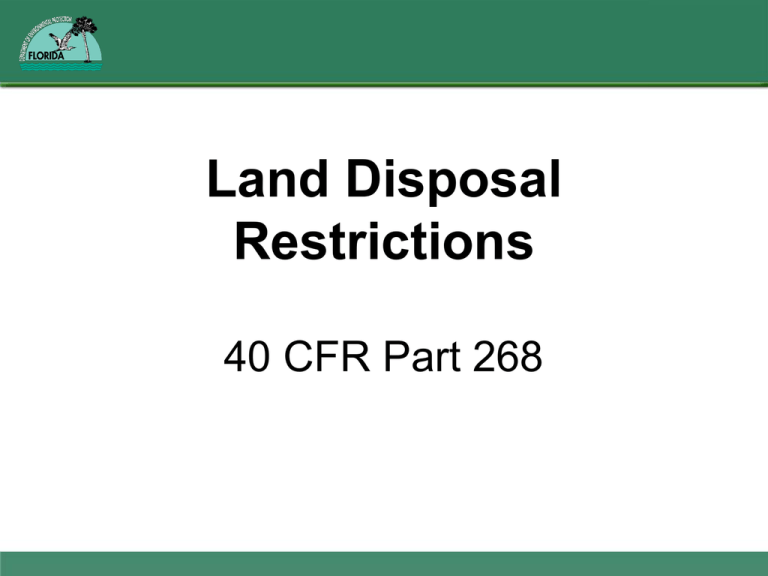
Land Disposal Restrictions 40 CFR Part 268 Why LDRs? 1976 RCRA Objective = Prevention Congressional Action • Hazardous And Solid Waste Amendments of 1984 – response to EPA issues – Required EPA to set treatment standards • • – Phased implementation Hard vs. Soft Hammers Required EPA to issue permits & rules • • Priority to Land Disposal & Incinerator permits SQG rules by 3/31/86 – Required all permitted facilities to assess releases from old unpermitted units And Mandated Land Disposal Restrictions • Prohibits land disposal of hazardous wastes – – – – Unless waste meets treatment standard set by EPA Treatment must reduce toxicity or reduce the mobility of the toxic constituents Listed wastes are still listed Treatment standard based on technology, not health • Exceptions – – – Case by case exemptions under 268.5 National Capacity variances ex. – debris (expired) “No migration” determination – some injection wells Land Disposal Restrictions • Purpose: – Reduce toxicity of waste – Reduce mobility of hazardous constituents • Where are the Rules?: – Underground Injection – 40 CFR 148 – LDRs - 40 CFR 268 Phased Implementation • • • Banned liquids in landfills Solvents & Dioxins- 11/8/86 “California List” - 7/8/87 – • Thirds 8/8/88, 6/8/89, 5/8/90 – • Acids, PCBs, liquid Halogenated Organic Compounds, liquids with CN, heavy metals EP toxicity wastes “Newly listed” wastes – – Phase II, III and IV TC toxicity wastes Treatment Standards • Currently in 40 CFR 268.40 for most wastes – Debris – 268.45 – Soil – 268.49 • Can be based on: – Total Constituent Concentration – Constituent Leachability by TCLP – Technology • A number of wastes still do not have accepted, reliable test methods Applicability • Does not apply to: – Waste that was not hazardous at the point of generation – CESQG waste, unless the CESQG is also a TSDF – Waste pesticides from farmers disposed of under 40 CFR 262.70 – Newly Listed wastes – Excluded Wastes • Universal Waste at Handler Facilities • De minimus loss of some characteristic wastes to CWA systems • Applies to everyone else Land Disposal Restrictions Key Definitions • Land Disposal – placement in or on the land, except in a Corrective Action Management Unit or staging pile, and includes, but is not limited to, placement in a landfill, surface impoundment, waste pile, injection well, land treatment facility, salt dome formation, salt bed formation, underground mine or cave, or placement in a concrete vault or bunker intended for disposal purposes.. Point of Generation • Point of Generation – LDRs attach at the point of generation of a waste. • This is complicated – When waste becomes a waste, when it leaves a unit, when it is no longer usable, > 90 days after a unit ceases to operate… • 261.3(b): – 1. When waste meets listing – 2. Mixture of a SW and a listed HW – 3. When waste exhibits a characteristic Dilution • Dilution Prohibition [40 CFR 268.3] – Can not in any way dilute a hazardous waste as a substitute for adequate treatment. – Serves two purposes: 1. Ensure actual treatment of hazardous waste 2. Ensure wastes are treated appropriately Impermissible Dilution • Addition of clean material to dilute contaminants • Solidification, unless the added sorbent also stabilizes the contaminants • Combustion of certain metal bearing wastes – If burned, must also contain burnable hazardous constituents or organic debris as generated • Adding agents such as iron filings to mask leachable lead in TCLP testing Allowed Dilution • Characteristic Wastes Only • Waste waters subsequently discharged pursuant to the Clean Water Act – Defers to Clean Water Act regarding allowable treatment • Not allowed if a treatment method other than DEACT is specified – High TOC organic ignitables – No solvents down the drain! Generator Requirements • Generator must determine if waste is banned • Generator must identify all EPA waste codes that apply to the waste – If a waste is D001-D040 for constituents other than the ones for the applicable listing – Improper HW identification is the most common violation that may lead to a LDR violation. • For characteristic wastes the generator must also identify any underlying hazardous constituents – Notify the disposal facility if present, or state that the waste must be treated for UHCs UHC Example • F006 listing constituents are – Cd, Cr, CN, Pb, Ni and Ag • If selenium is present above TC levels, and antimony is present at more than 1.15 mg/l TCLP, the disposal facility must be notified that antimony is present Generator Decisions • Generator can: – Decide not to make a determination of whether the waste must be treated – Make the determination that the waste is not subject to the LDRs. – Make the determination that the waste is subject to the LDRs. • And then treat the waste and make a new determination • Only some forms of treatment allowed • NO Thermal Treatment is allowed without a permit – Waste Water Evaporation? Generator Decisions • Generator can decide not to make a determination of whether the waste must be treated [40 CFR 268.7(a)(2)]. – One time notice to TSD and a copy in the file: • • • • • Waste Codes & Analysis data if available Treatability Group UHCs unless the waste will be treated for all UHCs Manifest number (of first shipment) “This hazardous waste may or may not be subject to the LDR treatment standards. The treatment facility must then make the determination.’ Generator Decision • If the Generator makes the determination that the waste meets the treatment standards at the original point of generation [40 CFR 268.7(a)(3)] : – One time notification to TSD and place a copy in the file • • • • • • Waste Codes Manifest number “Waste is subject to LDRs…” Wastewater/Non-wastewater category Constituents of concern and UHCs if applicable Certification “ I certify…” Generator Decisions • Generator can determine whether the waste must be treated prior to disposal – Testing or process knowledge [40 CFR 268.7] • Most usual Generator Requirements • If the Generator makes the determination that the waste does not meet the treatment standards at the original point of generation [40 CFR 268.7(a)(2)] : – One time notification to TSD and place a copy in the file • • • • • Waste Codes, treatability group Manifest number “Waste is subject to LDRs…” Wastewater/Non-wastewater category Constituents of concern and UHCs if applicable Generator Requirements • A new notice is required if the waste or disposal facility changes • Records need to be kept for three years from when the waste was last shipped to the disposal facility • Three years is automatically extended during the course of unresolved enforcement action. • Common issue is generator can not locate first time notification • Or does not keep a complete copy • Forms can include references codes or abbreviations from the back or second page • No national recordkeeping form Treatment Standards for Hazardous Waste 40 CFR 268.40 • All Hazardous wastes are listed on this table • Columns for: – Waste code – Waste description and treatment/regulatory subcategory – Regulated hazardous constituents – Wastewaters – concentration in mg/L or technology code – Nonwastewaters – concentrations in mg/kg unless noted as “mg/L TCLP” or technology code • May read ___ AND meet 268.48 standards Waste Codes • Very important to properly characterize all hazardous waste streams and add all appropriate waste codes in order to be in compliance with LDRs. • Example – see MSDSs - What are the appropriate waste codes? Categories and Subdivisions • Categories: – Wastewater – Wastes that contain less than 1% by weight Total Organic Carbon (TOC) and less than 1% by weight Total Suspended Solids (TSS). – Nonwastewater – Aren’t wastewaters • Subdivisions: – Listed in 40 CFR 268.40 • Examples: – D001 High TOC Subcategory – D008 Lead Acid Battery Subcategory Regulated Hazardous Constituent • What is the constituent that it the hazardous waste is listed for? – Examples: • cadmium, lead, MEK, toluene Wastewaters • Concentration in mg/L or technology code – Examples of Concentrations – • F005 MEK - .28mg/L • D008 Lead - .69mg/L and meet 268.48 standards – Examples of Treatment Technologies – • D002 - DEACT and meet 268.48 standards Nonwastewaters • Concentration in mg/kg unless noted as “mg/L TCLP” or technology code – Examples of Concentrations – • F005 MEK - .36mg/kg • D008 Lead - .75 mg/L TCLP and meet 268.48 standards – Examples of Treatment Technologies – • D001 High TOC – RORGS, CMBST, or POLYM • D008 lead acid batteries - RLEAD • (see 40 CFR 268.42 definitions) Underlying Hazardous Constituents (UHCs) • UHCs are any constituent listed in 40 CFR 268.48, Table UTS – Universal Treatment Standards – Except: (unless listed under specific wastes) • • • • • Fluoride Selenium Sulfides Vanadium Zinc • Reasonably expected to be in the waste at the Point of Generation at a concentration above the constituent-specific UTS Underlying Hazardous Constituents (UHCs) • • • • Regulated Constituent Common Name CAS number Wastewater Standard – Concentration in mg/L Nonwastewater Standard – Concentration in mg/kg unless noted “mg/L TCLP” Underlying Hazardous Constituents (UHCs) • Examples: – D002 waste – D002/D008 waste – D001/F003/F005 waste – D001 waste Alternate Treatment Standards • Alternate treatment standards: – Soil (40 CFR 268.49) – Debris (40 CFR 268.45) – Lab packs (40 CFR 268.42(c)) • Need to be incinerated • These wastes can not be placed into the lab pack if you use the alt. treatment standards – D009, F019, K003, K004, K005, K006, K062, K071, K100, K106, P010, P011, P012, P076, P078, U134, and U151 (268 Appendix IV) Characteristic Waste • 268.9(b) – Special rules regarding wastes that exhibit a characteristic: – Listed codes and characteristic codes must both be applied, except: • When the treatment standard for the listed codes operates in lieu of the treatment standard of the characteristic code Characteristic Waste • 268.9(b) – Special rules regarding wastes that exhibit a characteristic: – Examples: • • • • MEK – F005, not D035/F005 Perc – F002, not D039/F002 D001/F005 D001/F003/F005 Characteristic Waste • 268.9(b) – Paperwork required: • If waste no longer hazardous: – One time notice to file, not to Subtitle D facility (268.9(d)) • If waste no longer hazardous, but does not meet treatment standards: – Comply with 268.7(b)(4)(iv) Generator Treatment • Permissible if: – Generator complies with applicable parts of 262.34 – Containers, per 40 CFR 265 Subpart I – Tanks, per 40 CFR 265 Subpart J – Containment buildings, per 40 CFR 265 Subpart DD – Generator has a written Waste Analysis Plan – Based on detailed chemical and physical analysis – Keeps records documenting treatment and disposal – Certifications after treatment Wastes Treated On-Site Wastes Treated On-Site Wastes Treated On-Site • Deactivated Characteristic wastes managed in CWA systems: • One time notice to facility’s files • Describing generation • Describe exclusion • Disposition of waste • 268.7(a)(7) applies to wastes that are generated, then managed under an exclusion • TSDFs are also permitted to determine that wastes are excluded, after they receive them Other Resources • Main EPA LDR page: – http://www.epa.gov/osw/hazard/tsd/ldr/index.htm • EPA 2001 LDR Booklet: – http://www.epa.gov/osw/hazard/tsd/ldr/ldr-sum.pdf • EPA 2005 LDR Training Module: – http://www.epa.gov/osw/inforesources/pubs/training/ldr05.pdf • EPA Waste Analysis Plan Guidance: – http://www.epa.gov/osw/hazard/tsd/ldr/wap330.pdf Questions?
